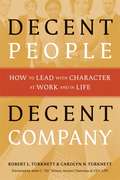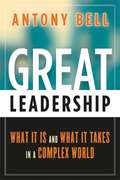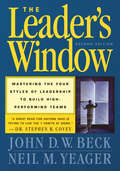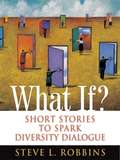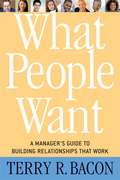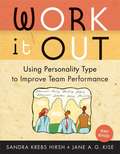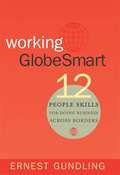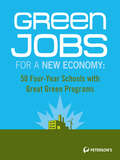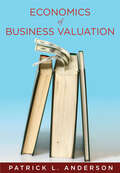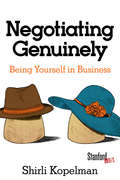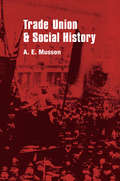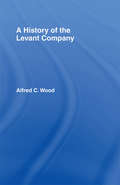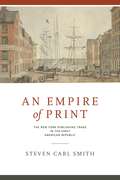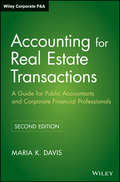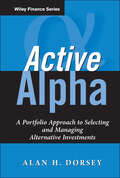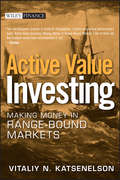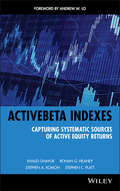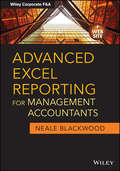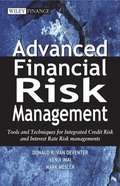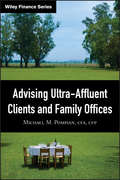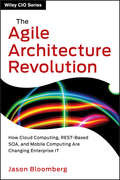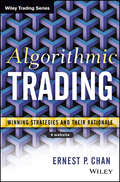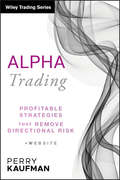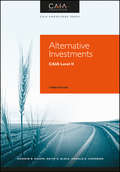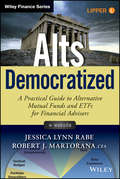- Table View
- List View
Decent People, Decent Company: How to Lead with Character at Work and in Life
by Robert L. Turknett Carolyn N. Turknett Kent C. NelsonThe inspiring people who lead with integrity, move things forward, garner commitment from others and are willing to ask the tough questions when necessary are the real leaders who generate and sustain cultures of character in organizations. Decent People, Decent Company puts the power to develop the core qualities of leadership character into the hands of anyone dedicated to bringing integrity, respect and personal responsibility back to the workplace. Drawing on more than 25 years of experience working with hundreds of CEOs, managers and teams, this innovative husband-and-wife team provides both the inspiration and the tools to help people move from asking "Why don't they?" to asking "What can I?" With their original and dynamic Leadership Character Model, the Turknetts have captured the essence of what it takes to revitalize attitudes and behavior, unleash leadership integrity and reinvigorate organizations. Decent People, Decent Company identifies the eight essential traits of leadership character: empathy, emotional mastery, lack of blame, humility, accountability, courage, self-confidence and focus on the whole. In chapters that focus on each quality, dozens of leaders bring to life the struggles and triumphs of developing the behaviors of character and ethical leadership required to bring out the best in everyone.
Great Leadership: What It Is and What It Takes in a Complex World
by Antony BellThe demand for leadership that is both competent and principled is essential to a business or an organization. Leadership development expert, Antony Bell, offers an easy workable template involving knowledge, skill and talent combined with the inner qualities of a leader that drive noble actions. Great Leadership is for any leader looking to take charge of his or her growth.This book compiles the research and writings of eminent thinkers like: Rosabeth Moss Kanter, Warren Bennis, Daniel Goleman and John Kotter in order to make leadership development as simple as possible. Bell introduces his "Three Dimensions of Leadership" model, and plenty of practical tools to help assess how to achieve leadership superiority when directing organizations, operations and people.By integrating leadership development with organizational development, Bell demonstrates the results when employees align with the organization's mission, commit to improving their productivity and collectively contribute to improving the corporate bottom line..
The Leader's Window: Mastering the Four Styles of Leadership to Build High-Performing Teams
by John D.W. Beck Neil YeagerThe Leader's Window presents an authoritative leadership system to help you give your employees what they need, when they need it, in a form in which they can use it. New and updated leader profiles and case examples illustrate the variety of successful strategies high-profile leaders use, while stories of misguided leadership show pitfalls to avoid. With new information on managing Generation X and adapting to diverse personality types, this classic resource presents the strategies you need to make the most of individual capabilities and simultaneously achieve goals. Charts, action lists, cases for reflection, process plans, performance contracts, self-assessments and tools to crease baseline leadership measures provide the help you need to harness the potential of each worker and transform that potential into results-driven teams.
What If?
by Steve Long-Nguyen RobbinsWhat If? delivers a highly creative and innovative new way to explore the issues that dominate today's multicultural, multiethnic workplace. To the twenty-five witty yet inspiring stories in this collection, Steve Long-Nguyen Robbins has added tips and suggestions for putting these key learnings into action. Combined, What If? offers a powerful lens into the human experience.
What People Want: A Manager's Guide to Building Relationships That Work
by Terry R. BaconManaging a diverse work-force requires flexibility and respect for each person's needs and differences. This book lays out a set of best practices that focus on the needs that matter most to co-workers and direct reports: trust, challenge, self worth, competence, appreciation, excitement and an ability to develop and sustain an identity of merit.
Work it Out: Using Personality Type to Improve Team Performance
by Sandra Krebs HirshWork It Out delivers a dynamic way to simplify the complex--and sometimes chaotic--interactions between people at work. With fresh insights on applying the power of personality type in executive coaching, experts Hirsh and Kise have built a solid foundation for helping individuals tap into their strengths, minimize unnecessary conflict, and learn to work more effectively with others. Dozens of hands-on exercises, intervention descriptions, and case studies put the power to implement these teambuilding and coaching strategies into the hands of any manager, consultant, business leader, or HR professional committed to improving communication, reducing stress, fostering sustainable change, and building strong, effective teams in organizations.
Working Globesmart: 12 People Skills for Doing Business Across Borders
by Janet A. KiseTaking a new assignment in your company's foreign office? Meeting a business associate from another country? Videoconferencing with a group of global co-workers? Negotiating a project deadline with the foreign software engineer across the hall? Learn how to apply a new set of cultural competencies to successfully cross national or cultural boundaries. Working GlobeSmart shows how global people skills add value to global business and captures the essence of what global leadership means: the ability to create a corporate culture that builds cooperation across borders and cultures, between customers and suppliers-across every organizational line.
Green Jobs for a New Economy: 50 Four-year Schools with Great Green Programs
by Peterson'SLooking for two-year schools with sustainability programs? These easy-to-read profiles are organized by state and province, and include the following information for accredited two-year schools in the United States, U.S. territories, and Canada that responded to Peterson's Survey of Sustainability Efforts in Higher Education online survey: Sustainability Initiatives, Academics, Student Services and Green Events, Food, Transportation, Buildings and Grounds, Recycling, Energy, Purchasing, and Contact Information. Featuring exclusive bonus section, "What Does Being Green Mean," which examines the current interest in sustainability, President Obama's "New Energy for America" program, and key green terms and definitions, with links to more than 20 green job boards and over 30 U.S. and global organizations that support sustainability.
Economics of Business Valuation
by Patrick L. AndersonFor decades, the market, asset, and income approaches to business valuation have taken center stage in the assessment of the firm. This book brings to light an expanded valuation toolkit, consisting of nine well-defined valuation principles hailing from the fields of economics, finance, accounting, taxation, and management. It ultimately argues that the "value functional" approach to business valuation avoids most of the shortcomings of its competitors, and more correctly matches the actual motivations and information set held by stakeholders. Much of what we know about corporate finance and mathematical finance derives from a narrow subset of firms: publicly traded corporations. The value functional approach can be readily applied to both large firms and companies that do not issue publicly traded stocks and bonds, cannot borrow without constraints, and often rely upon entrepreneurs to both finance and manage their operations. With historical side notes from an international set of sources and real-world exemplars that run throughout the text, this book is a future-facing resource for scholars in economics and finance, as well as the academically minded valuation practitioner.
Negotiating Genuinely: Being Yourself in Business
by illustrations by Ruth Gwily Shirli KopelmanWe often assume that strategic negotiation requires us to wall off vulnerable parts of ourselves and act rationally to win. But, what if you could just be you in business? Taking a positive approach, this brief distills years of research, teaching, and coaching into an integrated framework for negotiating genuinely. One of the most fundamental and challenging battlegrounds in our work lives, negotiation calls on us to compete and cooperate to do our jobs well and achieve extraordinary results. But, the biggest challenge in a negotiation is to be strategic while also being real. Author Shirli Kopelman argues that this duality is both possible and powerful. In Negotiating Genuinely, she teaches readers how to reconcile the disparate hats that they wear in everyday life—with families, friends, and colleagues—bringing one "integral hat" to the negotiation table. Kopelman develops and shares techniques that illuminate this approach; exercises along the way help readers to negotiate more naturally, positively, and successfully.
Trade Union and Social Studies
by H.E. MussonThere is perhaps no area of British life where attitudes are more strongly influenced by shared traditions and past experiences than the trade union movement; the memory of the working-class movements is a long one. It is therefore all the more important in the light of recent events to examine the origins and development of trade-union organization over the decades if we are to understand the unions of today, which have emerged as one of the most crucial and strongest elements in the economy. This book is the product of twenty years' detailed research and general reflection on the course of trade-union development, and ranges over the whole field of British trade-union history, from the early craft societies to the structure of modern trade unionism. It begins by illuminating the problems associated with researching and writing in this field, and goes on to trace the main trends of trade-union development, linking these with modern trade-union problems.
A History of the Levant Company
by Alfred C. WoodFirst Published in 1964. Routledge is an imprint of Taylor & Francis, an informa company.
An Empire of Print: The New York Publishing Trade in the Early American Republic (Penn State Series in the History of the Book)
by Steven Carl SmithHome to the so-called big five publishers as well as hundreds of smaller presses, renowned literary agents, a vigorous arts scene, and an uncountable number of aspiring and established writers alike, New York City is widely perceived as the publishing capital of the United States and the world. This book traces the origins and early evolution of the city’s rise to literary preeminence.Through five case studies, Steven Carl Smith examines publishing in New York from the post–Revolutionary War period through the Jacksonian era. He discusses the gradual development of local, regional, and national distribution networks, assesses the economic relationships and shared social and cultural practices that connected printers, booksellers, and their customers, and explores the uncharacteristically modern approaches taken by the city’s preindustrial printers and distributors. If the cultural matrix of printed texts served as the primary legitimating vehicle for political debate and literary expression, Smith argues, then deeper understanding of the economic interests and political affiliations of the people who produced these texts gives necessary insight into the emergence of a major American industry. Those involved in New York’s book trade imagined for themselves, like their counterparts in other major seaport cities, a robust business that could satisfy the new nation’s desire for print, and many fulfilled their ambition by cultivating networks that crossed regional boundaries, delivering books to the masses.A fresh interpretation of the market economy in early America, An Empire of Print reveals how New York started on the road to becoming the publishing powerhouse it is today.
Accounting for Real Estate Transactions
by Maria K. DavisAccounting for Real Estate Transactions, Second Edition is an up-to-date, comprehensive reference guide, specifically written to help professionals understand and apply the accounting rules relating to real estate transactions. This book provides financial professionals with a powerful tool to evaluate the accounting consequences of specific deals, enabling them to structure transactions with the accounting consequences in mind, and to account for them in accordance with US GAAP. Accountants and auditors are provided with major concepts, clear and concise explanations of real estate accounting rules, detailed applications of US GAAP, flowcharts, and exhaustive cross-references of the authoritative literature.
Active Alpha
by Alan H. DorseyPraise for Active Alpha"Active alpha is the quest for every sophisticated investor. This book covers all of the key alpha sources currently mined by active managers, reduces the complexity of the subject, and helps the investor get started in the right direction."-Mark Anson, Chief Executive Officer, Hermes Pensions Management Ltd."Long-held traditional methods for investing large portfolios are giving way to new processes that are designed to improve productivity and diversification. These changes find their locus in the sometimes overly mysterious world of absolute return strategies. In this book, Alan Dorsey demystifies that new world and provides a guiding pathway into the future of professional portfolio management. This is an important read for any investor who plans to succeed going forward."-Britt Harris, Chief Investment Officer, Teacher Retirement System of Texas"With great lucidity, Alan Dorsey's book, Active Alpha, fills an important void by identifying the relevant institutional features of this complex subject and by providing a unifying analytic framework for understanding and constructing portfolios of alternative assets. For anyone investing in the alternative class, from the new student to the experienced practitioner, Active Alpha is a necessary read. I am recommending it to everyone I know with such an interest, and it is destined to become a much thumbed reference on my shelf."-Steve Ross, Franco Modigliani Professor of Financial Economics, Sloan School, MIT
Active Value Investing
by Vitaliy N. KatsenelsonA strategy to profit when markets are range bound-which is half of the timeOne of the most significant challenges facing today's active investor is how to make money during the times when markets are going nowhere. Bookshelves are groaning under the weight of titles written on investment strategy in bull markets, but there is little guidance on how to invest in range bound markets. In this book, author and respected investment portfolio manager Vitaliy Katsenelson makes a convincing case for range-bound market conditions and offers readers a practical strategy for proactive investing that improves profits. This guide provides investors with the know-how to modify the traditional, fundamentally driven strategies that they have become so accustomed to using in bull markets, so that they can work in range bound markets. It offers new approaches to margin of safety and presents terrific insights into buy and sell disciplines, international investing, "Quality, Valuation, and Growth" framework, and much more.Vitaliy Katsenelson, CFA (Denver, CO) has been involved with the investment industry since 1994. He is a portfolio manager with Investment Management Associates where he co-manages institutional and personal assets utilizing fundamental analysis. Katsenelson is a member of the CFA Institute, has served on the board of CFA Society of Colorado, and is also on the board of Retirement Investment Institute. Vitaliy is an adjunct faculty member at the University of Colorado at Denver - Graduate School of Business. He is also a regular contributor to the Financial Times, The Motley Fool, and Minyanville.com.
ActiveBeta Indexes
by Ronan G. Heaney Stephen A. Komon Stephen C. Platt Khalid Ghayur Andrew W. LoAn informative guide offering new and innovative ways to think about active management and investingActiveBeta Indexes presents exciting new research that shows how above-market returns can be achieved in a low-cost, transparent, and efficient fashion. Active Betas reflect fundamental investment principles that have long been the foundation of active equity returns, but are commonly masqueraded as investment skill, or alpha. This groundbreaking book lifts the veil to uncover the common sources of active returns and reveals their beta-like properties.Developed by leading investment practitioners at Westpeak Global Advisors, ActiveBeta Indexes introduces Active Beta sources and explains how the behavior of short- and long-term earnings growth gives rise to systematic sources of active equity returns.Details a new index framework and research findings that could change the face of active portfolio managementPresents patent-pending innovations for constructing style indexes and informationally-efficient active portfoliosExplores the historical performance of ActiveBeta IndexesWealth advisers, consultants, pensions and endowments, and other institutional investors will find the intellectual honesty of ActiveBeta Indexes a refreshing perspective on the active management industry. They will also find it a useful guide to a more strategic allocation of their risk and management fee budgets - a growing necessity in these challenging times.
Advanced Excel Reporting for Management Accountants
by Neale BlackwoodThe advanced tools accountants need to build automated, reliable, and scalable reports using ExcelLearn about the functions that work together to automate many of the processes involved in Management Reporting. See how to take advantage of the many new features of Excel 2007 and 2010. Find out how to build validation structures into your spreadsheet reports. Discover how to identify missing or new codes, either in the creation process or in the day-to-day running of the reports. Do it all with Advanced Excel Reporting for Management Accountants.Explore the structures that simplify the report creation process and make the reports more maintainableLearn techniques to "cleanse" data so that it is ready for use in Pivot Tables and formula-based reportsFind out the tips and tricks that can make the creation process quicker and easierDiscover all you need to know about Excel's summing functions and how versatile they can beWritten in a hands-on style that works towards the completion of two reporting case studies, Advanced Excel Reporting for Management Accountants explains and demonstrates techniques so that Management Accountants can learn how to automate many aspects of the reporting process.
Advanced Financial Risk Management
by Mark Mesler Donald R. Van Deventer Kenji ImaiPractical tools and advice for managing financial risk, updated for a post-crisis worldAdvanced Financial Risk Management bridges the gap between the idealized assumptions used for risk valuation and the realities that must be reflected in management actions. It explains, in detailed yet easy-to-understand terms, the analytics of these issues from A to Z, and lays out a comprehensive strategy for risk management measurement, objectives, and hedging techniques that apply to all types of institutions. Written by experienced risk managers, the book covers everything from the basics of present value, forward rates, and interest rate compounding to the wide variety of alternative term structure models.Revised and updated with lessons from the 2007-2010 financial crisis, Advanced Financial Risk Management outlines a framework for fully integrated risk management. Credit risk, market risk, asset and liability management, and performance measurement have historically been thought of as separate disciplines, but recent developments in financial theory and computer science now allow these views of risk to be analyzed on a more integrated basis. The book presents a performance measurement approach that goes far beyond traditional capital allocation techniques to measure risk-adjusted shareholder value creation, and supplements this strategic view of integrated risk with step-by-step tools and techniques for constructing a risk management system that achieves these objectives.Practical tools for managing risk in the financial worldUpdated to include the most recent events that have influenced risk managementTopics covered include the basics of present value, forward rates, and interest rate compounding; American vs. European fixed income options; default probability models; prepayment models; mortality models; and alternatives to the Vasicek model Comprehensive and in-depth, Advanced Financial Risk Management is an essential resource for anyone working in the financial field.
Advising Ultra-Affluent Clients and Family Offices
by Michael PompianA timely guide for financial professionals looking to tap into the lucrative world of the ultra-affluentThe ultra affluent-defined here as those having $50 million or more in liquid assets-are an elite class who expect their financial advisors to not only preserve and grow their assets, but also help them with "soft" issues such as philanthropy and family governance. One of the biggest factors to success in this field is the relationship between the client and the advisor. In Advising Ultra-Affluent Clients and Family Offices, author and practicing investment consultant Michael Pompian provides a practical introduction to who the ultra-affluent actually are and reveals what it takes to build and maintain a solid relationship with them. Filled with in-depth insights and expert advice, this unique resource offers valuable information on issues that every advisor to the ultra-affluent must be familiar with.
The Agile Architecture Revolution
by Jason BloombergA sneak peek at up-and-coming trends in IT, a multidimensional vision for achieving business agility through agile architecturesThe Agile Architecture Revolution places IT trends into the context of Enterprise Architecture, reinventing Enterprise Architecture to support continuous business transformation. It focuses on the challenges of large organizations, while placing such organizations into the broader business ecosystem that includes small and midsize organizations as well as startups.Organizes the important trends that are facing technology in businesses and public sector organizations today and over the next several yearsPresents the five broad organizing principles called Supertrends: location independence, global cubicle, democratization of technology, deep interoperability, and complex systems engineeringProvides a new perspective on service-oriented architecture in conjunction with architectural approaches to cloud computing and mobile technologies that explain how organizations can achieve better business visibility through IT and enterprise architectureLaying out a multidimensional vision for achieving agile architectures, this book discusses the crisis points that promise sudden, transformative change, unraveling how organizations' spending on IT will continue to undergo radical change over the next ten years.
Algorithmic Trading
by Ernie ChanPraise for Algorithmic Trading"Algorithmic Trading is an insightful book on quantitative trading written by a seasoned practitioner. What sets this book apart from many others in the space is the emphasis on real examples as opposed to just theory. Concepts are not only described, they are brought to life with actual trading strategies, which give the reader insight into how and why each strategy was developed, how it was implemented, and even how it was coded. This book is a valuable resource for anyone looking to create their own systematic trading strategies and those involved in manager selection, where the knowledge contained in this book will lead to a more informed and nuanced conversation with managers."-DAREN SMITH, CFA, CAIA, FSA, Managing Director, Manager Selection & Portfolio Construction, University of Toronto Asset Management"Using an excellent selection of mean reversion and momentum strategies, Ernie explains the rationale behind each one, shows how to test it, how to improve it, and discusses implementation issues. His book is a careful, detailed exposition of the scientific method applied to strategy development. For serious retail traders, I know of no other book that provides this range of examples and level of detail. His discussions of how regime changes affect strategies, and of risk management, are invaluable bonuses."-Roger Hunter, Mathematician and Algorithmic Trader
Alpha Trading
by Perry J. KaufmanFrom a leading trading systems developer, how to make profitable trades when there are no obvious trendsHow does a trader find alpha when markets make no sense, when price shocks cause diversification to fail, and when it seems impossible to hedge? What strategies should traders, long conditioned to trend trading, deploy? In Alpha Trading: Profitable Strategies That Remove Directional Risk, author Perry Kaufman presents strategies and systems for profitably trading in directionless markets and in those experiencing constant price shocks. The bookDetails how to exploit new highs and lowsDescribes how to hedge primary risk components, find robustness, and craft a diversification programOther titles by Kaufman: New Trading Systems and Methods, 4th Edition and A Short Course in Technical Trading, both by WileyGiven Kaufman's 30 years of experience trading in almost every kind of market, his Alpha Trading will be a welcome addition to the trading literature of professional and serious individual traders for years to come.
Alternative Investments: CAIA Level II
by Keith H. Black Hossein Kazemi Donald R. Chambers CAIA AssociationIn-depth Level II exam preparation direct from the CAIA Association CAIA Level II is the official study guide for the Chartered Alternative Investment Analyst professional examination, and an authoritative guide to working in the alternative investment sphere. Written by the makers of the exam, this book provides in-depth guidance through the entire exam agenda; the Level II strategies are the same as Level I, but this time you'll review them through the lens of risk management and portfolio optimisation. Topics include asset allocation and portfolio oversight, style analysis, risk management, alternative asset securitisation, secondary market creation, performance and style attribution and indexing and benchmarking, with clear organisation and a logical progression that allows you to customise your preparation focus. This new third edition has been updated to align with the latest exam, and to reflect the current practices in the field. The CAIA designation was developed to provide a standardized knowledge base in the midst of explosive capital inflow into alternative investments. This book provides a single-source repository of that essential information, tailored to those preparing for the Level II exam. Measure, monitor and manage funds from a risk management perspective Delve into advanced portfolio structures and optimisation strategies Master the nuances of private equity, real assets, commodities and hedge funds Gain expert insight into preparing thoroughly for the CAIA Level II exam The CAIA Charter programme is rigorous and comprehensive, and the designation is globally recognised as the highest standard in alternative investment education. Candidates seeking thorough preparation and detailed explanations of all aspects of alternative investment need look no further than CAIA Level II.
Alts Democratized
by Jessica Lynn Rabe Robert J. MartoranaA Comprehensive Review of the Liquid Alts Market and How '40 Act Products Can Enhance Client PortfoliosLiquid alternatives give investors access to hedge fund strategies with the benefits of '40 Act products: lower fees, higher liquidity, greater transparency, and improved tax efficiency.Alts Democratized is a hands-on guide that offers financial advisors and individual investors the tools and analysis to enhance client portfolios using alternative mutual funds and ETFs. Well-grounded in research and replete with more than 100 exhibits of Lipper data, Alts Democratized profiles the top ten funds in each of the eleven Lipper liquid alt classifications. This includes total net assets, fund flows, risk and return metrics, and the factor exposures that drive performance and help explain correlations to various forms of beta. Jessica Lynn Rabe and Robert J. Martorana, CFA, combine this research with a comprehensive framework for fund selection and portfolio construction to enhance the asset allocation process, facilitate portfolio customization, and manage client expectations.In addition, the book includes functional perspectives on issues pertinent to financial advisors such as fees, client suitability, and volatility management. This helps advisors apply the concepts to portfolios and offer actionable investment advice. The authors also interviewed executives at leading wealth management firms to provide color on industry trends and best practices.The companion website provides ancillary materials that reinforce and supplement the book, including:The authors' top ten takeawaysClassification cheat sheetPortfolio construction guide (full color)Talking points for clientsQ&A on liquid altsPresentation with all 118 exhibits from the book (full color) Alts Democratized comprises a complete resource for the advisor seeking new sources of alpha, diversification, and hedging of tail risks.
